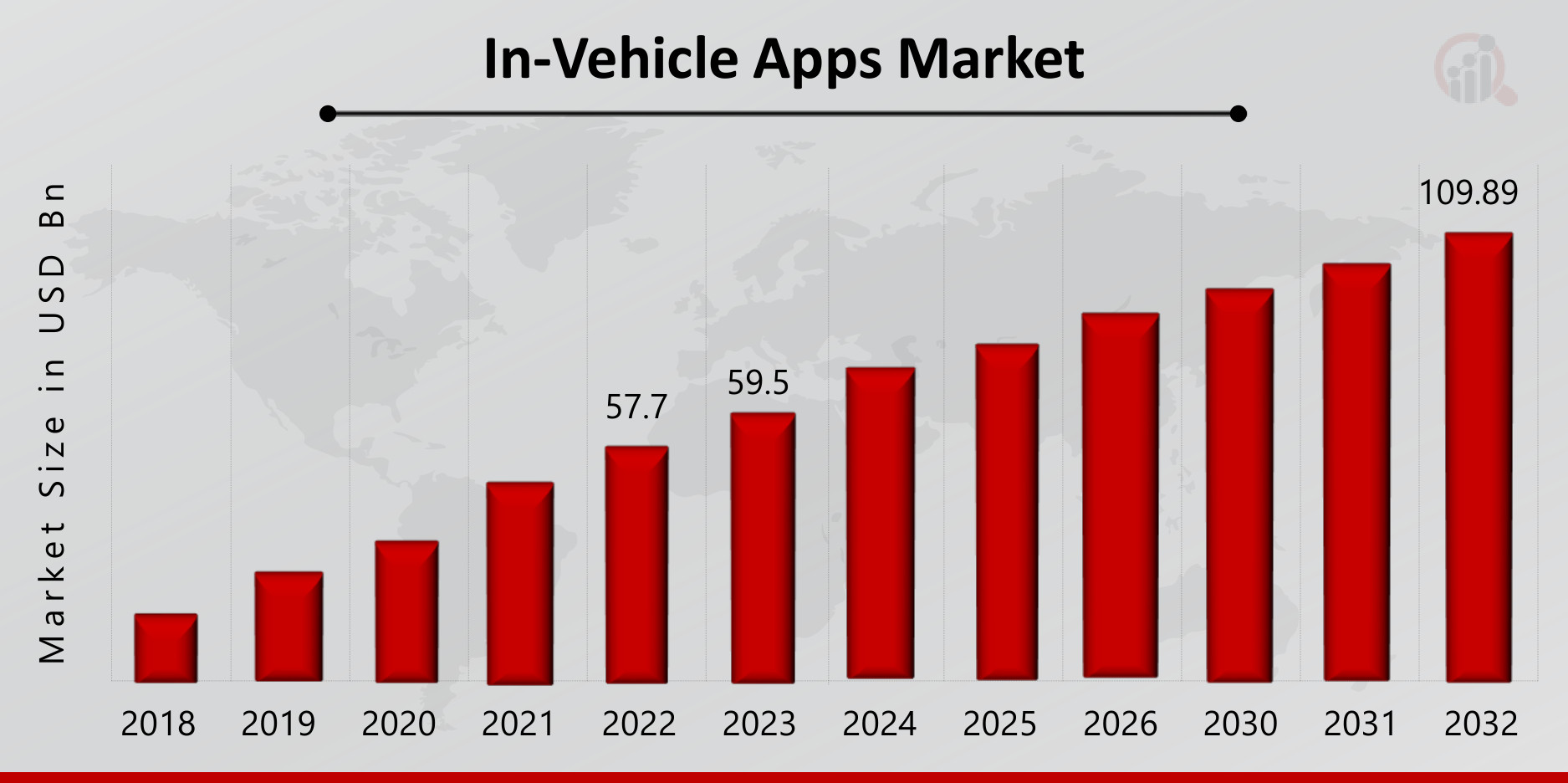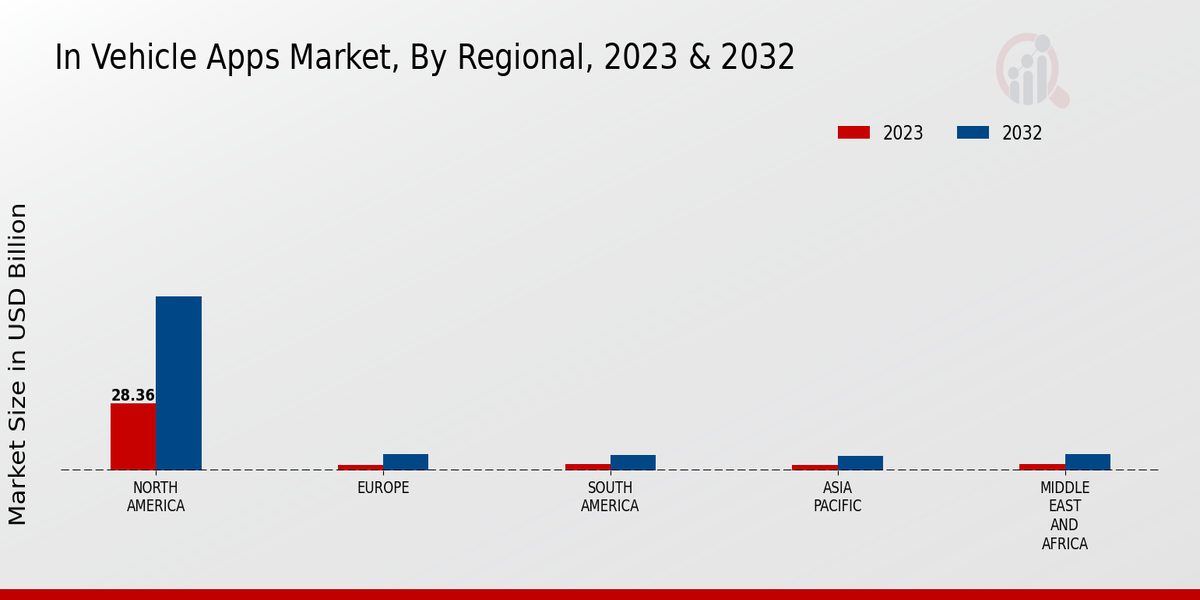Global In-Vehicle Apps Market Overview
As per MRFR analysis, the In-Vehicle Apps Market Size was estimated at 73.89 (USD Billion) in 2024. The In-Vehicle Apps Market Industry is expected to grow from 80.24 (USD Billion) in 2025 to 168.48 (USD Billion) till 2034, at a CAGR (growth rate) is expected to be around 8.59% during the forecast period (2025 - 2034).
Key In Vehicle Apps Market Trends Highlighted
Prominent trends in the In-Vehicle app market revolve around the integration of advanced technologies such as artificial intelligence (AI) and machine learning (ML) to enhance user experience and safety. The proliferation of connected and autonomous vehicles (CAVs) presents significant growth opportunities for in-vehicle apps, as they provide a platform for real-time data exchange, remote diagnostics, and personalized services. Additionally, the increasing demand for in-vehicle infotainment, navigation, and convenience applications drives market expansion.
Key market drivers include the growing adoption of smartphones and the rise of 5G technology, which enables faster data transmission and seamless connectivity. Opportunities lie in the development of apps tailored to specific vehicle types and user demographics, as well as the integration of emerging technologies like augmented reality (AR) and virtual reality (VR) to enhance the in-vehicle experience.

Source: Primary Research, Secondary Research, MRFR Database and Analyst Review
In-Vehicle Apps Market Drivers
Rising Adoption of Advanced Driver Assistance Systems (ADAS)
The integration of ADAS features, such as lane departure warning, adaptive cruise control, and automatic emergency braking, is propelling the demand for in-vehicle apps. These systems rely on real-time data and connectivity to enhance driving safety and convenience, creating a favorable environment for the growth of in-vehicle apps. The increasing adoption of ADAS across various vehicle segments is expected to drive the demand for in-vehicle apps in the coming years.The In-Vehicle Apps Market Industry is projected to grow exponentially in the years to come.
Growing Popularity of Connected Vehicles
The surge in connected vehicles is another significant factor driving the growth of the in-vehicle app market. Connected vehicles offer seamless connectivity, allowing drivers to access a wide range of apps and services while on the road. This includes navigation, entertainment, remote vehicle diagnostics, and safety features. The growing adoption of connected vehicles is increasing the demand for in-vehicle apps, as they provide a convenient and integrated platform for drivers to interact with their vehicles and the surrounding environment.
Increasing Demand for Personalized Driving Experiences
Consumers are increasingly seeking personalized driving experiences tailored to their preferences and needs. In-vehicle apps offer a unique opportunity to meet this demand by providing customized content, services, and features. These apps can be tailored to individual driving habits, preferences, and usage patterns, enhancing the overall driving experience. The growing focus on personalization is expected to further drive the adoption of in-vehicle apps in the Global In Vehicle Apps Market Industry.
In-Vehicle Apps Market Segment Insights
In-Vehicle Apps Market Type Insights
The In-Vehicle Apps Market is segmented by Type into Native In-Vehicle Apps, Embedded Apps, and Smartphone-Integrated Apps. Among these segments, Native In-Vehicle Apps are expected to hold the largest market share in 2023, owing to their seamless integration with the vehicle's operating system and advanced features such as navigation, entertainment, and vehicle diagnostics. Embedded Apps, which are pre-installed on the vehicle's infotainment system, are also expected to witness significant growth due to their convenience and cost-effectiveness.
This growth is attributed to the increasing adoption of connected vehicles, the rising demand for in-vehicle infotainment and navigation systems, and the growing popularity of smartphone-based apps. Key market players in the In-Vehicle Apps Market include Google, Apple, HERE Technologies, TomTom, Garmin, and Continental AG. These players are investing heavily in research and development to introduce innovative and user-friendly in-vehicle apps.

Source: Primary Research, Secondary Research, MRFR Database and Analyst Review
In-Vehicle Apps Market Functionality Insights
The Functionality segment of the In-Vehicle Apps Market is anticipated to grow significantly in the coming years. In 2023, the Navigation sub-segment held the largest market share, and it is expected to maintain its dominance throughout the forecast period. The growth of this sub-segment can be attributed to the increasing adoption of advanced navigation systems that offer real-time traffic updates, lane guidance, and other features. The Infotainment sub-segment is also expected to witness substantial growth, driven by the rising popularity of in-vehicle entertainment systems that provide access to music, movies, and other content.
Connected Car Services is another key sub-segment that is expected to contribute significantly to the overall market growth. These services enable vehicles to connect to the internet and access a wide range of applications and services, such as remote diagnostics, vehicle tracking, and emergency assistance. The Diagnostics and Maintenance sub-segment is expected to grow steadily as a result of the increasing demand for vehicle maintenance and repair services. Finally, the Vehicle Customization sub-segment is expected to experience moderate growth, driven by the growing trend of consumers personalizing their vehicles with custom apps and accessories.
In-Vehicle Apps Market Platform Insights
The In-Vehicle Apps Market segmentation by Platform comprises Android Automotive, Apple CarPlay, Linux-based Systems, and OEM Proprietary Systems. Android Automotive led the market with a revenue of $12.5 billion in 2023, capturing over 40% of the market share. Its open-source nature, wide developer ecosystem, and integration with Google services drive its dominance. Apple CarPlay follows closely, with a revenue of $8.7 billion and a market share of around 29%. Its seamless integration with iOS devices and user-friendly interface contribute to its popularity.
Linux-based Systems, such as Automotive Grade Linux (AGL), are gaining traction due to their flexibility and cost-effectiveness. OEM Proprietary Systems, developed by automakers like Tesla and Ford, offer customized experiences but have a limited market share due to their proprietary nature. As per In-Vehicle Apps Market data, the Platform segment is projected to witness steady growth over the forecast period, driven by increasing vehicle connectivity and demand for enhanced in-vehicle experiences.
In-Vehicle Apps Market Vehicle Type Insights
The Vehicle Type segment of the In-Vehicle Apps Market is categorized into Passenger Cars, Commercial Vehicles, and Heavy Duty Vehicles. Passenger Cars hold the largest market share due to the increasing demand for advanced infotainment systems and safety features. The demand for in-vehicle apps in Commercial Vehicles is also rising as fleet managers seek to improve efficiency and productivity. Heavy Duty Vehicles are expected to witness significant growth in the coming years, driven by the adoption of autonomous driving technologies. The In-Vehicle Apps Market revenue for Passenger Cars is projected to reach $22.5 billion by 2024, while Commercial Vehicles and Heavy Duty Vehicles are estimated to generate $10.2 billion and $5.3 billion, respectively.
In-Vehicle Apps Market Regional Insights
The In-Vehicle Apps Market is segmented into North America, Europe, APAC, South America, and MEA. North America is the largest regional market, accounting for over 40% of the global revenue in 2023. The region is expected to continue to dominate the market over the forecast period, driven by the growing adoption of connected cars and the increasing demand for in-vehicle entertainment and information services. Europe is the second-largest regional market, followed by APAC. APAC is expected to witness the fastest growth over the forecast period, driven by the increasing demand for in-vehicle apps in emerging markets such as China and India.South America and MEA are smaller regional markets, but they are expected to experience steady growth over the forecast period.

Source: Primary Research, Secondary Research, MRFR Database and Analyst Review
In-Vehicle Apps Market Key Players And Competitive Insights
Major players in the In-Vehicle Apps Market industry are continuously investing in research and development to introduce innovative products and services. Leading In-Vehicle app market players are also focusing on strategic partnerships and collaborations to expand their market reach and strengthen their competitive position. The In-Vehicle app market is expected to witness significant growth in the coming years, driven by increasing demand for connected and autonomous vehicles.
New entrants in the In-Vehicle Apps Market are also emerging, offering innovative solutions and challenging the established players. The competitive landscape of the In-Vehicle Apps Market is expected to remain dynamic, with continuous innovation and new product launches expected.A leading player in the In-Vehicle app market, Apple offers a range of in-vehicle apps through its CarPlay platform. CarPlay allows users to access their favorite apps while driving, including navigation, music, messaging, and more. Apple has partnered with a number of automakers to integrate CarPlay into their vehicles, including BMW, Ford, and Toyota. Apple's strong brand recognition and extensive app ecosystem give it a competitive edge in the In-Vehicle app market.Another major player in the In-Vehicle Apps Market, Google, offers its Android Auto platform. Android Auto provides a similar range of features to CarPlay, including navigation, music, messaging, and more.
Google has partnered with a number of automakers to integrate Android Auto into their vehicles, including Audi, Honda, and Volkswagen. Google's Android operating system is the most popular mobile operating system in the world, giving it a large potential market for its In-Vehicle Apps.
Key Companies in the In-Vehicle Apps Market Include
- Garmin
- Qualcomm Technologies, Inc.
- Tesla Motors, Inc.
- Baidu Inc
- HERE Technologies
- Harman
- Apple Inc.
- TomTom International B.V
- Google LLC
- Continental AG
- Robert Bosch GmbH
- Visteon Corporation
- Panasonic Corporation
- Delphi Technologies PLC
In-Vehicle Apps Market Industry Developments
The In-Vehicle Apps Market size was valued at USD 59.5 billion in 2023 and is projected to reach USD 109.89 billion by 2032, exhibiting a CAGR of 8.59% during the forecast period. Increasing demand for connected vehicles, growing adoption of smartphones and tablets, and advancements in automotive technology are the key factors driving the growth of the market.Some recent developments in the In-Vehicle Apps Market include:- In January 2023, HARMAN International, a leading provider of connected car solutions, announced the launch of its new in-vehicle app platform, Ignite.
The Platform enables automakers to create and deploy customized in-vehicle apps and services.- In March 2023, Google announced a partnership with Volvo Cars to integrate Google Assistant and Google Play Store into Volvo's next-generation vehicles. This partnership will provide Volvo drivers with access to a wide range of in-vehicle apps and services.These developments indicate that the In-Vehicle Apps Market is poised for continued growth in the coming years as automakers and technology companies invest in new and innovative ways to enhance the driving experience.
In-Vehicle Apps Market Segmentation Insights
In-Vehicle Apps Market Type Outlook
-
- Native In-Vehicle Apps
- Embedded Apps
- Smartphone-Integrated Apps
In-Vehicle Apps Market Functionality Outlook
-
- Navigation
- Infotainment
- Connected Car Services
- Diagnostics and Maintenance
- Vehicle Customization
In-Vehicle Apps Market Platform Outlook
-
- Android Automotive
- Apple CarPlay
- Linux-based Systems
- OEM Proprietary Systems
In-Vehicle Apps Market Vehicle Type Outlook
-
- Passenger Cars
- Commercial Vehicles
- Heavy-Duty Vehicles
In-Vehicle Apps Market Regional Outlook
-
- North America
- Europe
- South America
- Asia-Pacific
- Middle East and Africa
| Report Attribute/Metric |
Details |
|
Market Size 2024
|
73.89 (USD Billion)
|
|
Market Size 2025
|
80.24 (USD Billion)
|
|
Market Size 2034
|
168.48 (USD Billion)
|
|
Compound Annual Growth Rate (CAGR)
|
8.59% (2025 - 2034)
|
|
Report Coverage
|
Revenue Forecast, Competitive Landscape, Growth Factors, and Trends
|
|
Base Year
|
2024
|
|
Market Forecast Period
|
2025 - 2034
|
|
Historical Data
|
2019 - 2023
|
| Market Forecast Units |
USD Billion |
| Key Companies Profiled |
Garmin, Qualcomm Technologies, Inc., Tesla Motors, Inc., Baidu Inc, HERE Technologies, Harman, Apple Inc. , TomTom International B.V, Google LLC, Continental AG, Robert Bosch GmbH, Visteon Corporation, Panasonic Corporation, Delphi Technologies PLC |
| Segments Covered |
Type, Functionality, Platform, Vehicle Type, Regional |
| Key Market Opportunities |
Increasing adoption of connected vehicles Growing demand for personalized infotainment services Integration of AI and machine learning Expansion of cloud-based services Rise of autonomous vehicles |
| Key Market Dynamics |
Rising adoption of connected car technologies Increasing demand for in-car entertainment and convenience Growing penetration of smartphones and tablets Government regulations and industry standards Advancements in-vehicle infotainment systems |
| Countries Covered |
North America, Europe, APAC, South America, MEA |
Frequently Asked Questions (FAQ) :
The In-Vehicle Apps Market is expected to reach a valuation of USD 73.89 billion by 2024 and is projected to register a CAGR of 8.59% from 2025 to 2034, reaching a valuation of USD 168.48 billion by 2034.
The Asia-Pacific region is expected to be the fastest-growing region in the In-Vehicle Apps Market, with a CAGR of 12.5% from 2023 to 2032. This growth is attributed to the increasing adoption of connected vehicles and the growing demand for in-vehicle entertainment and navigation systems in the region.
In-vehicle apps are used for a variety of applications, including navigation, entertainment, communication, and vehicle diagnostics. Navigation apps are the most popular type of in-vehicle app, and they are expected to continue to grow in popularity as the number of connected vehicles increases.
The key competitors in the In-Vehicle Apps Market include Apple, Google, HERE Technologies, TomTom, and Garmin. These companies offer a variety of in-vehicle apps and services, and they are expected to continue to compete aggressively for market share in the coming years.
The key trends driving the growth of the Global In-Vehicle app market include the increasing adoption of connected vehicles, the growing demand for in-vehicle entertainment and navigation systems, and the development of new and innovative in-vehicle apps. These trends are expected to continue to drive the growth of the market in the coming years.
The In-Vehicle Apps Market faces a number of challenges, including the high cost of developing and deploying in-vehicle apps, the need for regulatory compliance, and the security risks associated with connected vehicles. These challenges are expected to continue to impact the growth of the market in the coming years.
The In-Vehicle Apps Market is expected to continue to grow in the coming years, driven by the increasing adoption of connected vehicles and the growing demand for in-vehicle entertainment and navigation systems. The market is expected to reach a valuation of USD 109.89 billion by 2032.
The key opportunities for growth in the In-Vehicle Apps Market include the development of new and innovative in-vehicle apps, the expansion of the market into new regions, and the development of partnerships between automakers and technology companies.
The key threats to growth in the In-Vehicle Apps Market include the high cost of developing and deploying in-vehicle apps, the need for regulatory compliance, and the security risks associated with connected vehicles.
Key recommendations for stakeholders in the In-Vehicle Apps Market include investing in the development of new and innovative in-vehicle apps, expanding into new regions, and developing partnerships with automakers and technology companies.





























